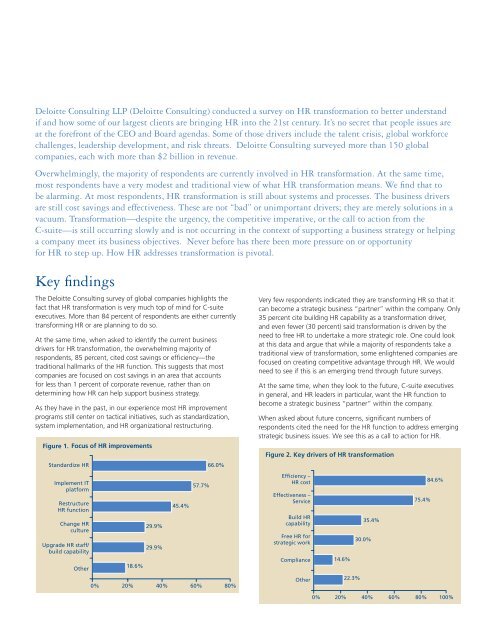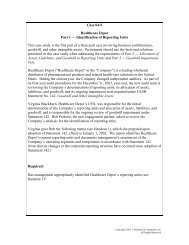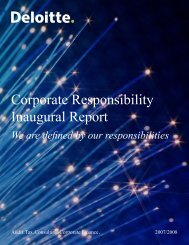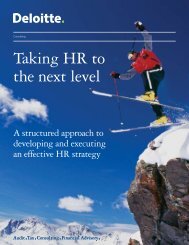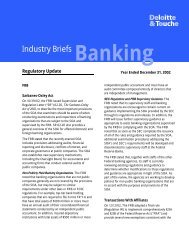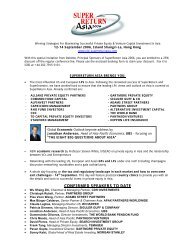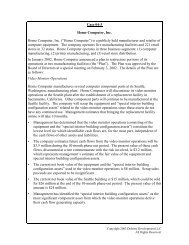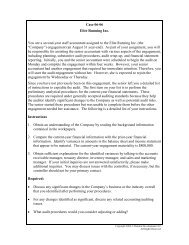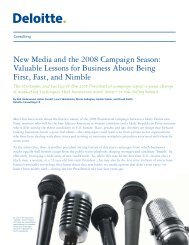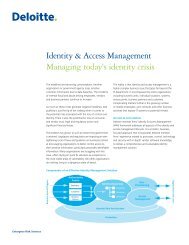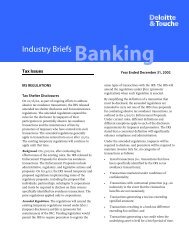HR Transformation Survey: A case for business driven HR - Deloitte
HR Transformation Survey: A case for business driven HR - Deloitte
HR Transformation Survey: A case for business driven HR - Deloitte
Create successful ePaper yourself
Turn your PDF publications into a flip-book with our unique Google optimized e-Paper software.
<strong>Deloitte</strong> Consulting LLP (<strong>Deloitte</strong> Consulting) conducted a survey on <strong>HR</strong> trans<strong>for</strong>mation to better understandif and how some of our largest clients are bringing <strong>HR</strong> into the 21st century. It’s no secret that people issues areat the <strong>for</strong>efront of the CEO and Board agendas. Some of those drivers include the talent crisis, global work<strong>for</strong>cechallenges, leadership development, and risk threats. <strong>Deloitte</strong> Consulting surveyed more than 150 globalcompanies, each with more than $2 billion in revenue.Overwhelmingly, the majority of respondents are currently involved in <strong>HR</strong> trans<strong>for</strong>mation. At the same time,most respondents have a very modest and traditional view of what <strong>HR</strong> trans<strong>for</strong>mation means. We fi nd that tobe alarming. At most respondents, <strong>HR</strong> trans<strong>for</strong>mation is still about systems and processes. The <strong>business</strong> driversare still cost savings and effectiveness. These are not “bad” or unimportant drivers; they are merely solutions in avacuum. <strong>Trans<strong>for</strong>mation</strong>—despite the urgency, the competitive imperative, or the call to action from theC-suite—is still occurring slowly and is not occurring in the context of supporting a <strong>business</strong> strategy or helpinga company meet its <strong>business</strong> objectives. Never be<strong>for</strong>e has there been more pressure on or opportunity<strong>for</strong> <strong>HR</strong> to step up. How <strong>HR</strong> addresses trans<strong>for</strong>mation is pivotal.Key fi ndingsThe <strong>Deloitte</strong> Consulting survey of global companies highlights thefact that <strong>HR</strong> trans<strong>for</strong>mation is very much top of mind <strong>for</strong> C-suiteexecutives. More than 84 percent of respondents are either currentlytrans<strong>for</strong>ming <strong>HR</strong> or are planning to do so.At the same time, when asked to identify the current <strong>business</strong>drivers <strong>for</strong> <strong>HR</strong> trans<strong>for</strong>mation, the overwhelming majority ofrespondents, 85 percent, cited cost savings or efficiency—thetraditional hallmarks of the <strong>HR</strong> function. This suggests that mostcompanies are focused on cost savings in an area that accounts<strong>for</strong> less than 1 percent of corporate revenue, rather than ondetermining how <strong>HR</strong> can help support <strong>business</strong> strategy.As they have in the past, in our experience most <strong>HR</strong> improvementprograms still center on tactical initiatives, such as standardization,system implementation, and <strong>HR</strong> organizational restructuring.Figure 1. Focus of <strong>HR</strong> improvementsStandardize <strong>HR</strong> 66.0%Implement ITplat<strong>for</strong>mRestructure<strong>HR</strong> functionChange <strong>HR</strong>cultureUpgrade <strong>HR</strong> staff/build capabilityOther18.6%29.9%2.9%2.9%29.9%45.4%57.7%0% 20% 40% 60% 80%Very few respondents indicated they are trans<strong>for</strong>ming <strong>HR</strong> so that itcan become a strategic <strong>business</strong> “partner” within the company. Only35 percent cite building <strong>HR</strong> capability as a trans<strong>for</strong>mation driver,and even fewer (30 percent) said trans<strong>for</strong>mation is <strong>driven</strong> by theneed to free <strong>HR</strong> to undertake a more strategic role. One could lookat this data and argue that while a majority of respondents take atraditional view of trans<strong>for</strong>mation, some enlightened companies arefocused on creating competitive advantage through <strong>HR</strong>. We wouldneed to see if this is an emerging trend through future surveys.At the same time, when they look to the future, C-suite executivesin general, and <strong>HR</strong> leaders in particular, want the <strong>HR</strong> function tobecome a strategic <strong>business</strong> “partner” within the company.When asked about future concerns, significant numbers ofrespondents cited the need <strong>for</strong> the <strong>HR</strong> function to address emergingstrategic <strong>business</strong> issues. We see this as a call to action <strong>for</strong> <strong>HR</strong>.Figure 2. Key Drivers drivers of <strong>HR</strong> <strong>Trans<strong>for</strong>mation</strong>trans<strong>for</strong>mationFigure 2. Key Drivers of <strong>HR</strong> <strong>Trans<strong>for</strong>mation</strong>Efficiency –Efficiency <strong>HR</strong> cost –84.6%<strong>HR</strong> cost84.6%Effectiveness –Effectiveness Service–75.4%Service 75.4%Build <strong>HR</strong>capability Build <strong>HR</strong>capabilityFree <strong>HR</strong> <strong>for</strong>strategic Free <strong>HR</strong> work <strong>for</strong>strategic workCompliance 14.6%Compliance 14.6%Other 22.3%Other 22.3%35.4%35.4%30.0%30.0%0% 20% 40% 60% 80% 100%0% 20% 40% 60% 80% 100%


